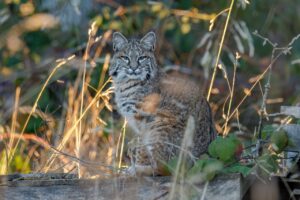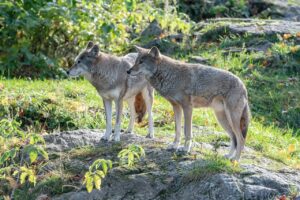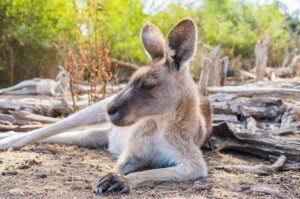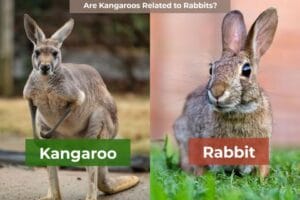Many wild animals share some relationship, either mutual, parasitic, or competitive. Wolves and bears are no different.
Both bears and wolves are apex predators, sometimes in the same natural habitat. There are many misconceptions about both of these animals getting along fine in the wild.
In this article, I will answer the question, “Do Wolves and Bears Get Along?” and also provide information about both animals.
Before we get started to understand the relationship between a bear and a wolf, let us learn a little bit about them.
Wolf Profile

Scientific Name: Canis lupus
Wolves are also known as the grey wolf or gray wolf. They are canines found throughout Eurasia and North America.
These large predators are social and highly intelligent. Wolves live in packs and work together to hunt and protect their territory.
Since wolves are primarily carnivores, they have to rely on their keen senses and teamwork to bring down much larger prey.
An adult wolf can reach 160 cm (63 in) in length. Wolves can weigh differently depending on the location. European wolves weigh 38.5 kg (85 lb), Indian and Arabian wolves 25 kg (55 lb), and North American wolves 36 kg (79 lb).
They can also come in different colours like white, brown, grey, and black.
An average wolf pack is made up of five to eight wolves. This includes two adults, juveniles, and yearlings.
Bear Profile

Family: Ursidae
Unlike wolves, bears prefer to live a solitary life in the wild. They are found throughout the continents of North America, South America, and Eurasia.
Bears exist in the same habitat as wolves, and their encounters are mostly common.
They are omnivores, meaning they feed on both plants and animals. Bears have a variety of diets, from berries and insects to fish and large mammals.
A bear can be active during the day and at night, and just like wolves, they have an excellent sense of smell.
Do Wolves and Bears Get Along?
Wolves and bears naturally do not get along because both predators feed on the same type of prey, which includes rodents, deer, and small animals. Both of these animals are always ready to fight over territory, mainly because they inhabit the same region.
Although bears and wolves do not get along, there have been instances where both animals displayed a close friendship, or rather, cooperation.
In 2013, a photographer known as Lassi Rautiainen took pictures while observing a wolf and brown bear displaying some form of cooperation. The interaction lasted for 10 days in the wild in Khumo, Finland.
This sight was not something that normally happens, as wild animals such as wolves prefer to stick with their species when hunting or moving around in the wild. Even bears prefer a life of solitude, so what led to their friendship?
Another example of wolves and bears coexisting peacefully is the large grey wolf pack that was spotted cooperating with a grizzly bear in Wyoming’s Yellowstone National Park.
The video of the encounter was filmed by Josh Welter, a field naturalist, in October 2021. It showed that both apex predators can get along for a mutual benefit.
In the wild, wolves and bears might try to avoid each other to prevent conflict. Wolves might hunt at different times of the day to avoid bears, or they might be in areas that are less frequented by bears. Bears can also move to areas with more food sources to limit encounters with wolves.
Although there is no particular reason both species can decide to cooperate, I have come up with a few reasons.
Reasons Why Wolves and Bears May Get Along
1. Scavenging
While wolves and bears are assumed to be competitors in the wild, they can coexist peacefully due to mutual scavenging opportunities.
Both species prefer the same type of prey, and when opportunities present themselves, they may choose to tolerate each other for a share.
2. Food
It might be expected for wolves and bears to share the same area during seasons when food is abundant. During this time, there is enough to go around and no need for competition.
3. Stress or Trauma
Another reason for their relationship is related to the stress or trauma of being separated from their social group. A wolf that has been ostracised from its pack might seek friendship, and the bear might feel a single wolf is not a threat.
So being cooperative benefits both of them in terms of hunting.
Why Wolves and Bears May Not Get Along
1. Competition
Since both species feed on the same food and require the same resources, there is serious competition during scarcity.
Another factor that contributes to this competition is the tug of war over food. This can happen when one side has worked so hard for their meal, but suddenly the other appears to claim it.
Bears are known to use their big size to intimidate packs and steal their food. This can lead to a standoff when there is resistance from the wolves.
2. Territorial Disputes
Both wolves and bears are territorial animals. They have their own unique ways of marking their territory.
For wolves, they mark their territory with scent markings, howling, and physical markers. Bears, on the other hand, use scent and physical displays to establish dominance. They can rub their bodies against trees while scratching the bark.
Since they can overstep each other’s territory, conflicts can arise. This can then lead to serious confrontations.
Best Places to See Wolves and Bears in the Wild
There are few places where bears and wolves coexist in the same environment. Most of these places are located in North America, Europe, and Asia.
If you are planning to visit the United States of America or Canada, there are a few national parks where both species live together in the wild.
Here are some places to encounter both wildlife:
- Yellowstone National Park, USA
- Denali National Park, Alaska, USA
- Katmai National Park, Alaska, USA
- Voyageurs National Park, Minnesota, USA
- Great Bear Rainforest, British Columbia, Canada
- Scandinavia (Norway, Sweden, Finland)
You are sure to see both wolves and bears in their natural habitat in these locations. In Yellowstone National Park, they can be seen moving freely in the Lamar Valley and Hayden Valley areas.
Conclusion
At this point, you now understand the kind of mutual relationship wolves and bears share in the wild. In this article, I have provided answers to the popular question of whether bears and wolves get along.
Although bears and wolves might get along for a common benefit, they can also be a threat to each other if their goals are not aligned.
Next time you see these two predators together in the wild, remember to capture that wonderful moment.
FAQs
Can a bear and a wolf be friends?
It is uncommon for bears and wolves to form friendships. However, they may occasionally cooperate for mutual benefit.
Do wolves and bears ever hunt together?
No, wolves and bears do not hunt together. They are more likely to compete for the same prey rather than cooperate.
Can a wolf pack drive away a bear?
Yes, a determined wolf pack can sometimes drive away a bear, especially if they are defending their territory or food.

Hi, I’m Louis Ojibe, and I grew up around wildlife in Africa. I have always been fascinated by animals and nature across the world.
As a child, my parents used to take me to see wild animals like lions, elephants, gorillas, tortoises, and many others at our local zoo.












